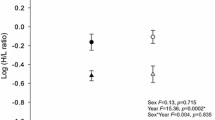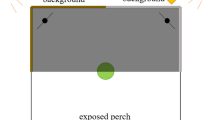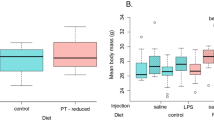Abstract—
In passerine birds, the coloration of plumage is associated with two groups of pigments (melanins and carotenoids). The physiological bases of the appearance of melanin- and carotenoid-based coloration are fundamentally different, and these types of coloration reflect different characteristics of an individual. It is considered that the expressiveness of melanin-based coloration primarily depends on genetic factors, while the expressiveness of carotenoid-based coloration depends on the state and health of an individual at the moment. Therefore, the individual variability of these two types of coloration should be independent of each other. We studied the coloration of the second (from the distal edge) rectrix in 109 greenfinch males of two age cohorts (one year old and aged two or more years). The relationship between the level of aggressiveness of different birds and their color characteristics was also considered. The feathers we are interested in are two-color; their distal part is black (or blackish), while the proximal part (basis) is yellow. The black color is caused by melanins, while the yellow one by carotenoids. We demonstrated that the saturation of yellow carotenoid-based coloration in greenfinch males has a significant and negative relationship with the length of the black (melanin) spot on the same rectrix (the relationship of the saturation of the yellow coloration with the length of the yellow field is, respectively, positive). Thus, the individual variability of melanin- and carotenoid-based coloration in our case is parallel. This indicates that the roles of these groups of pigments as indicators (markers) of the quality and state of an individual were not as fundamentally different as is commonly thought. However, there are definitely differences in this regard between melanin- and carotenoid-based coloration: the black melanin-based coloration in the greenfinch is associated with aggressiveness, while the yellow carotenoid-based one is not.



Similar content being viewed by others
REFERENCES
Abolins-Abols, M., Kornobis, E., Ribeca, P., Wakamatsu, K., Peterson, M.P., Ketterson, E.D., and Mila, B., Differential gene regulation underlies variation in melanic plumage coloration in the dark-eyed junco (Junco hyemalis), Mol. Ecol., 2018, vol. 27, pp. 4501–4515.
Badyaev, A.V. and Hill, G.E., Evolution of sexual dichromatism: contribution of carotenoid- versus melanin-based coloration, Biol. J. Linn. Soc., 2000, vol. 69, pp. 153–172.
Bókony, V., Garamszegi, L.Z., Hirschenhauser, K., and Liker, A., Testosterone and melanin-based black plumage coloration: a comparative study, Behav. Ecol. Sociobiol., 2008, vol. 62, pp. 1229–1238.
Costantini, D. and Møller, A.P., Carotenoids are minor antioxidants for birds, Funct. Ecol., 2008, vol. 22, pp. 367–370.
Decker, A. and McGinnis, J., Black pigmentation in feathers of buff orpington chicks is caused by vitamin D deficiency, Proc. Soc. Exp. Biol., 1947, vol. 66, pp. 224–228.
Ducrest, A.-L., Keller, L., and Roulin, A., Pleiotropy in the melanocortin system, coloration and behavioural syndromes, Trends Ecol. Evol., 2008, vol. 23, pp. 502–510.
Griffith, S.C., Parker, T.H., and Olson, V.A., Melanin- versus carotenoid-based sexual signals: is the differences really so black and red?, Anim. Behav., 2006, vol. 71, pp. 749–763.
Guindre-Parker, S. and Love, O.P., Revisiting the condition-dependence of melanin-based plumage, J. Avian Biol., 2014, vol. 45, pp. 29–33.
Hill, G.E., Energetic constraints on expression of carotenoid-based plumage coloration, J. Avian Biol., 2000, vol. 31, pp. 559–566.
Hõrak, P., Ots, I., Vellau, H., Spottiswoode, C., and Møller, A.P., Carotenoid-based plumage coloration reflects hemoparasite infection and local survival in breeding great tits, Oecologia, 2001, vol. 126, pp. 166–173.
Hõrak, P., Saks, L., Karu, U., Ots, I., Surai, P.F., and McGraw, K.J., How coccidian parasites affect health and appearance of greenfinches, J. Anim. Ecol., 2004, vol. 73, pp. 935–947.
Hõrak, P., Sild, E., Soomets, U., Sepp, T., and Kilk, K., Oxidative stress and information content of black and yellow plumage coloration: an experiment with greenfinches, J. Exp. Biol., 2010, vol. 213, pp. 2225–2233.
Karu, U., Saks, L., and Hõrak, P., Carotenoid coloration in greenfinches is individually consistent irrespective of foraging ability, Physiol. Biochem. Zool., 2007, vol. 80, pp. 663–670.
Koch, R.E., Kavazis, A.N., Hasselquist, D., Hood, W.R., Zhang, Y., Toomey, M.B., and Hill, G.E., No evidence that carotenoid pigments boost either immune of antioxidant defenses in a songbird, Nat. Commun., 2018, vol. 9, p. 491.
Lindström, K. and Lundström, J., Male greenfinches (Carduelis chloris) with brighter ornaments have higher virus infection clearance rate, Behav. Ecol. Sociobiol., 2000, vol. 48, pp. 44–51.
McGraw, K., Mechanisms of carotenoid-based coloration, in Bird Coloration, vol. 1: Mechanisms and Measurements, Hill, G.E. and McGraw, K.J., Eds., Cambridge, MA: Harvard Univ. Press, 2003, pp. 177–242.
McGraw K., Mechanisms of melanin-based coloration, in Bird Coloration, vol. 1: Mechanisms and Measurements, Hill, G.E. and McGraw, K.J., Eds., Cambridge, MA: Harvard Univ. Press, 2003a, pp. 243–294.
McGraw, K. and Hill, G.E., Carotenoid-based ornamentation and status signalling in the house finch, Behav. Ecol., 2000, vol. 11, pp. 520–527.
McGraw, K.J., Hill, G.E., Stradi, R., and Parker, R.S., The influence of carotenoid acquisition and utilization on the maintenance of species-typical plumage pigmentation in male American goldfinches (Carduelis tristis) and northern cardinals (Cardinalis cardinalis), Physiol. Biochem. Zool., 2001, vol. 74, pp. 843–852.
Merilä, J., Sheldon, B.C., and Lindström, K., Plumage brightness in relation to haematozoan infections in the greenfinch Carduelis chloris: bright males are a good bet, Ecoscience, 1999, vol. 6, pp. 12–18.
Mosalov, A.A. and Koblik, E.A., Coloration traits as markers of basal groups of song passerines (Oscines, Passeriformes, Aves), Tr. Menzbir. Ornitol. O-va, 2017, no. 3, pp. 96–111.
Navara, K.J. and Hill, G.E., Dietary carotenoid pigments and immune function in a songbird with extensive carotenoid-based plumage coloration, Behav. Ecol., 2003, vol. 14, pp. 909–916.
Pryke, S.R., Andersson, S., Lawes, M.J., and Piper, S.E., Carotenoid status signaling in captive and wild red-collared widowbirds: independent effects of badge size and color, Behav. Ecol., 2002, vol. 13, pp. 622–631.
R Core Team, R: A Language and Environment for Statistical Computing, Vienna, 2020. https://www.R-project.org.
Réale, D., Reader, S.M., Sol, D., McDougall, P.T., and Dingemanse, N.J., Integrating animal temperament within ecology and evolution, Biol. Rev., 2007, vol. 82, pp. 291–318.
Riedler, R., Pesme, C., Druzik, J., Gleeson, M., and Pearlstein, E., A review of color-producing mechanisms in feathers and their influence on preventive conservation strategies, J. Am. Inst. Conserv., 2014, vol. 53, pp. 44–65.
Roulin, A., Condition-dependence, pleiotropy and the handicap principle of sexual selection in melanin-based colouration, Biol. Rev., 2016, vol. 91, pp. 328–348.
Saks, L., McGraw, K.J., and Hõrak, P., How feather colour reflects its carotenoid content, Funct. Ecol., 2003, vol. 17, pp. 555–561.
Sánchez-Tójar, A., Nakagawa, S., Sánchez-Fortún, M., Martin, D.A., Ramani, S., Girndt, A., Bókony, V., Kempenaers, B., Liker, A., Westneat, D.F., Burke, T., and Schroeder, J., Meta-analysis challenges a textbook example of status signalling and demonstrates publication bias, eLife, 2018, vol. 7, p. e37385.
Schielzeth, H., Kempenaers, B., Ellegren, H., and Forstmeier, W., QTL linkage mapping of zebra finch beak color shows an oligogenic control of a sexually selected trait, Evolution, 2012, vol. 66, pp. 18–30.
Siefferman, L. and Hill, G.E., Structural and melanin coloration indicate parental effort and reproductive success in male eastern bluebirds, Behav. Ecol., vol. 14, pp. 855–861.
Simons, M.J.P., Cohen, A.A., and Verhulst, S., What does carotenoid-dependent coloration tell? Plasma carotenoid level signals immunocompetence in birds—a meta-analysis, PLoS One, 2012, vol. 7, p. e43088.
Slagsvold, T. and Lifjeld, J.T., Plumage color in a condition-dependent sexual trait in male pied flycatchers, Evolution, 1992, vol. 46, pp. 825–828.
Stoddard, M.C. and Prum, R.O., How colorful are birds? Evolution of the avian plumage color gamut, Behav. Ecol., 2011, vol. 22, pp. 1042–1052.
Stoehr, A.M. and Hill, G.E., The effects of elevated testosterone on plumage hue in male house finches, J. Avian Biol., 2001, vol. 32, pp. 153–158.
Svensson, L., Identification Guide to European Passerines, Stockholm, 1992, 4th ed.
Svobodová, J., Gabrielová, B., Synek, P., Marsik, P., Vanĕk, T., Albrecht, T., and Vinkler, M., The health signaling of ornamental traits in the grey partridge (Perdix perdix), J. Ornithol., 2013, vol. 154, pp. 717–725.
Svobodová, J., Gabrielová, B., Hyršl, P., Albrecht, T., and Vinkler, M., Melanin and carotenoid ornaments are related to the individual condition in free-living grey partridges (Perdix perdix), J. Ornithol., 2016, vol. 157, pp. 1007–1015.
Thompson, C.W., Hillgarth, N., Leu, M., and McClure, H.E., High parasite load in house finches (Carpodacus mexicanus) is correlated with reduced expression of a sexually selected trait, Am. Nat., 1997, vol. 149, pp. 270–294.
Veiga, J.P. and Puerta, M., Nutritional constraints determine the expression of a sexual trait in the house sparrow, Passer domesticus, Proc. R. Soc. London, Ser. B, 1996, vol. 263, pp. 229–234.
Weaver, R.J., Santos, E.S.A., Tucker, A.M., Wilson, A.E., and Hill, G.E., Carotenoid metabolism strengthens the link between feather coloration and individual quality, Nat. Commun., 2018, vol. 9, article no. 73, pp. 1–9.
Wendeln, H. and Becker, P.H., Effects of parental quality and effort on the reproduction of common terns, J. Anim. Ecol., 1999, vol. 68, pp. 205–214.
Wolfenbarger, L.L., Red coloration of male northern cardinals correlated with mate quality and territory quality, Behav. Ecol., 1999, vol. 10, pp. 80–90.
Funding
This work was carried out within the topic of the State Assignment 2013—2020, project no. AAAA-A18-118042690110-1(0119-2019-0003) “Ecological and Evolutionary Aspects of Behavior and Communication of Animals.”
Author information
Authors and Affiliations
Corresponding author
Ethics declarations
Conflict of interest. The authors declare that they have no conflicts of interest.
Statement of the welfare of animals. All applicable international, national, and/or institutional guidelines for the care and use of animals were followed.
Additional information
Translated by A. Barkhash
Rights and permissions
About this article
Cite this article
Diatroptov, M.E., Opaev, A.S. Melanin- and Carotenoid-Based Coloration of Plumage and the Level of Aggressiveness: The Relationship of These Parameters in the Greenfinch (Chloris chloris, Passeriformes, Fringillidae). Biol Bull Russ Acad Sci 49, 1482–1490 (2022). https://doi.org/10.1134/S1062359022090102
Received:
Revised:
Accepted:
Published:
Issue Date:
DOI: https://doi.org/10.1134/S1062359022090102




